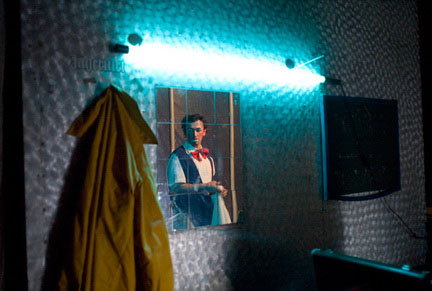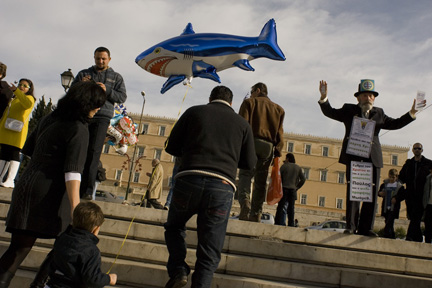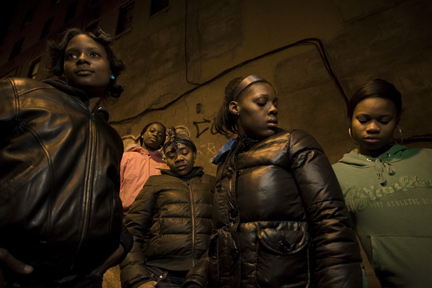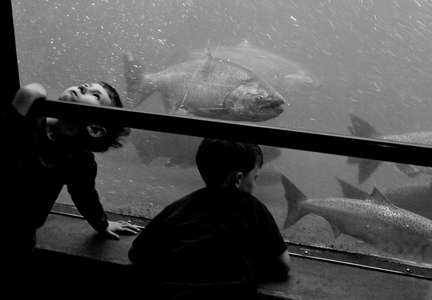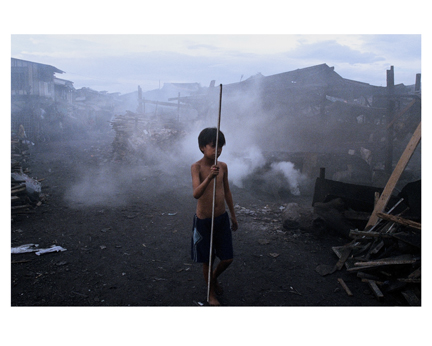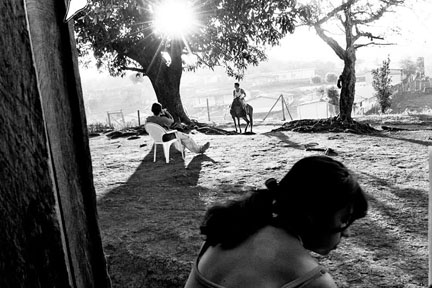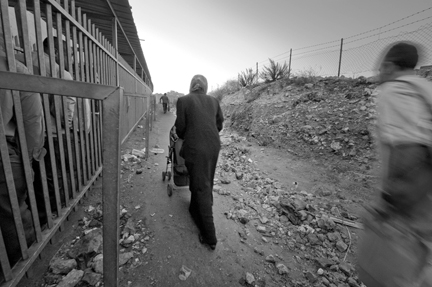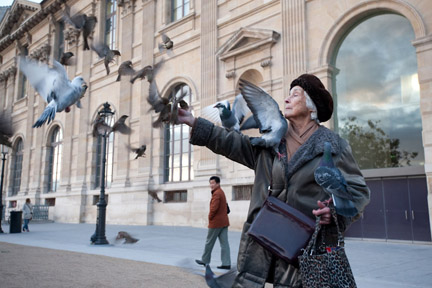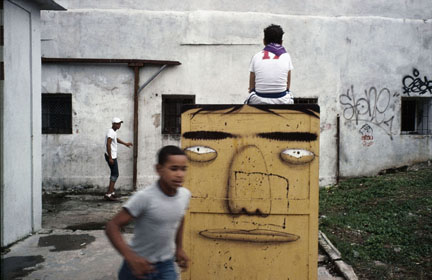We asked photographers this month to select an indelible image –– one photograph they encountered early on as a photographer that still lingers with them today. We’re especially pleased to include an indelible image from Darius Himes, one of the country’s foremost experts on the photo book, who is also a photographer, writer, and publisher. And thanks to everyone who submitted an indelible image. Because we had so many responses to the column, we’ll run THE INDELIBLE IMAGE II next month. –– Alex and Rebecca
DARIUS HIMES ON HARRY CALLAHAN

Harry Callahan, Aix-en-Provence, 1958
One of the first photographers I was introduced to, as a young teenage boy, was Harry Callahan. The introduction came by way of the cover of Henry Horenstein’s Black and White Photography. My father had purchased the book at the suggestion of a colleague, and while the technical language was still far above me, I was deeply impressed by the work chosen. Callahan’s graceful black-and-white image of barren trees in winter not only spoke to me due to the subject matter—I grew up just across the Mississippi River in Iowa, a mere 3 hours from Chicago, where I presume Callahan made this photograph—but also because of the graphic power of the world rendered in shades of black, white, and gray.
But the photograph of Callahan’s that I most responded to, then and now, is his photograph of 1958, Aix-en-Provence, France. Actually, that statement is a bit of a falsehood. There are so many photographs of Callahan’s that I respond to, that to narrow it to one particular image is like asking for a favorite passage from Shakespeare! There are so many that are appropriate for so many situations. But nonetheless, what moves me about this image is the wildness of the underbrush and the seeming impenetrability of the scene. And yet, the more you look, the more things are revealed, by which I mean, the more deeply it impresses itself upon you, untethering your own inner eye along the way. Merely informational facts are not what I’m talking about; what I’m hinting at are the multitude of ways that the outer world has been transformed into a powerful two dimensional, abstracted image. I’m talking about the very transformative power of photography in the hands of an acutely sensitive artist.
There is a concept that is a clarifying one for me that relates to my attraction to this photograph. In both Eastern and Western cosmology is the notion of the mirror-connectedness of the Book of Revelation and the Book of Creation. Here is one exemplary, brief passage that speaks to this subject, from Persian-born Baha’u’llah. “Look at the world and ponder a while upon it. It unveileth the book of its own self before thine eyes and revealeth that which the Pen of thy Lord, the Fashioner, the All-Informed, hath inscribed therein”* John Ruskin, the 19th century British writer and social commentator expressed it this way.
There is religion in everything around us,
a calm and holy religion
in the unbreathing things of nature.
It is a meek and blessed influence,
stealing in as it were unaware upon the heart;
It comes quickly, and without excitement;
It has no terror, no gloom,
It does not rouse up the passions;
It is untrammeled by creeds….
There are a great many photographers and artists who have approached the world around them with awe and wonder. In this image, I see a precursor to photographers like Hiroshi Sugimoto and Thomas Joshua Cooper, as well as echoes of artists as varied as Nio Hokusai, Kandinsky, and the darker aspects of Whistler’s painting oeuvre. What Callahan seems to have mastered, to me at least, was the ability to gaze, with deep intent, at his “immediate” surroundings, without feeling the need to either exoticize nor degrade what he looked at and what he ultimately decided to photograph, allowing “the book of its own self” to reveal itself in all of its own inherent beauty. This is a powerful role that the arts can play in our society and in helping us advance our fledgling, world-embracing civilization.––Darius Himes
* (Baha’u’llah: Tablets of Baha’u’llah, pp. 141-142)
Darius’s websites:
http://www.dariushimes.com
http://www.radiusbooks.org
For more about Harry Callahan:
http://www.stephendaitergallery.com/dynamic/artist.asp?ArtistID=25
To see Hiroshi Sugimoto’s work:
http://www.sugimotohiroshi.com/
To see some of Thomas Joshua Cooper’s work:
http://artnews.org/artist.php?i=735
ALEX WEBB ON HENRI CARTIER-BRESSON

Henri Cartier-Bresson, Valencia, Spain, 1933
My father, when he was struggling with writer’s block––which, unfortunately, was all too often––turned to photography, and as a result had a fine collection of photographic books. At about the age of fourteen, I started to sift through these books in his study. As I pored through The Decisive Moment, I remember coming upon this Cartier-Bresson image from Valencia, Spain. I’d never seen anything quite like it. As I marveled at the echoing rings of the mismatched spectacle lenses and the half-target on the door, set against––in deep space––that slightly twisted, ambiguous figure in the doors behind, I remember thinking: How can someone see this way? How can someone find such an enigmatic moment in the world and bring it back as a photograph? I began to sense something about perception, about the moment, about space, and about the unique possibilities of the photograph. I’ve never forgotten this image.––Alex Webb
To see more of Henri Cartier-Bresson’s work:
http://www.magnumphotos.com
REBECCA NORRIS WEBB ON WRIGHT MORRIS

Wright Morris, Clothing on Hooks, 1947
Formerly a writer, I was attracted early on as a photographer to two books that combine text and images: Walker Evans and James Agee’s Let Us Now Praise Famous Men and Wright Morris’s God’s Country and My People. Both bodies of work expanded my way of looking at the photo book, and eventually led to my intermingling the two in my own work. Yet, there was something about the lesser-known, Nebraskan-born Morris’s photo-text book –– in which he interweaves his writing and his photographs –– that touched something deeper and more inexplicable in me. Morris’s work is aloof yet engaging, bare-bones yet mysterious, spacious yet intimate –– it is work that suggests the many paradoxes that make up the Great Plains itself, where, like Morris, I also grew up,
I’m not sure exactly how his work manages to evoke all of this in me. Perhaps it’s because Wright Morris’s objects are often photographed so sparely, yet with such intensity, it creates a kind of space around them. And this space creates a kind of suggestiveness, ripe for poetic reverie in the viewer, not unlike the experience of driving across the Nebraska or South Dakota prairie with few if any trees or houses to fetter the mind, the memory, the imagination. So, for me, Morris’s spare objects suggest the Great Plains –- like this photograph of the tattered coats and hat –– as well as evoking a different kind of landscape, a kind of private and interior Nebraska, one that suggests what all that emptiness feels like to an insider, someone who grew up on the Great Plains, and the Great Plains “…grew up in you,” to quote Morris.
And, lastly, there are his accompanying texts that somehow speak to –- or perhaps I should say, speak for –– the photos, texts that are as spare and distilled and intense as the photographs themselves. I find the text pieces as plainspoken and mesmerizing and mysterious as a Weldon Kees poem, a poet who also grew up in Nebraska. Reading Morris creates a kind of expansiveness in me, a kind of ache and a kind of delight, which is often my response to the Great Plains. And, I’m not sure why, but as soon as I finish reading one of his more luminous pieces (like the one I’ve included below), I find myself starting the process all over again –– a sign, they say, of truly poetic writing.––Rebecca Norris Webb
The man who lives his own life, and wears it out, can dispense with the need of taking it with him. He dies his own death or he goes on living, and where the life has worn in the death will come out. Skin and bones, jacket and shoes, tools, sheds and machines wear out; even the land wears out and the seat wears off the cane- bottom chair. The palms wear off the gloves, the cuffs off the sleeves, the nickel off the doorknobs, the plate off the silver, the flowers off the plates, the shine off the stovepipe, the label off the flour sacks, the enamel off the dipper, the varnish off the checkers, and the gold off the Christmas jewelry, but every day the nap wears off the carpet the figure wears in. A pattern for living, the blueprint of it, can be seen in the white stitches of the denim, the timepiece stamped like a medallion in the bib of the overalls. Between wearing something in and wearing it out the line is as vague as the receding horizon, and as hard to account for as the missing hairs of a brush. The figure that began on the front of the carpet has moved around to the back.––Wright Morris
For more about Wright Morris:
http://monet.unk.edu/mona/first/morris/morris.html
For more about Weldon Kees (including my favorite poem of his “1926”):
http://mockingbird.creighton.edu/Ncw/kees.htm

